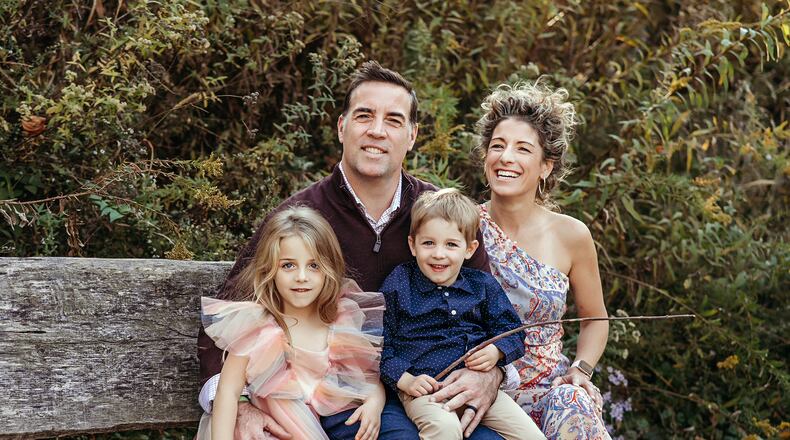Mike Perrich and his wife Emily, now of Loveland, met as college students at UD in 2001. Emily, an Alter High School graduate, is a year younger than her husband, who grew up in Kettering and graduated from Centerville High School. After college, Mike started his career as a marketing manager in the hospitality industry and Emily became a personal shopper for Saks Fifth Avenue in Cincinnati.
“We spent the first 10 years together living in downtown Cincinnati,” Mike said. “We decided to get married in 2015 at our favorite place – the Cincinnati Museum Center.”
As the couple started their family, which now includes daughter Meritt, 5 and son Macklan, “Mack,” 3, they continued visits to their favorite place in Cincinnati and the whole family loved it. So it seemed like a perfect idea that when Mike had a rare day off from work in August before starting a new job in Columbus, he’d take his son to spend a fun day at the museum.
“Mack was begging to go,” Emily said. “It seemed like a day like any other.”
Mike and Emily are both active and they got up that morning early to do their workouts.
“I like to hike or ride the indoor bike like five or six miles,” Mike said. “I got that done and got Mack ready to go.”
Emily remembers Mike texting her later that morning to let her know Mack was having a great time. She didn’t head into work that day but was doing chores at home when an unknown number came across her phone screen.
“It went to voicemail, and it was from an Officer Simon from the Cincinnati Police Department,” Emily said. “So I called him back right away.’
Police told Emily that her husband had suffered a medical emergency at the museum and that he was on his way to the University of Cincinnati Medical Center for treatment. Mike was just 40 years old.
Chloe Keil, a museum engagement specialist, was nearby when Mike collapsed and because she remembered learning CPR in high school, immediately raced to the scene.
“We thought it was a guest who had a seizure,” Keil said. “But when I got there, he had no pulse.”
Keil hadn’t taken a CPR refresher course but had used the American Heart Association’s CPR Kiosk on site at the museum and said she quickly remembered the process.
“I immediately thought I had to go help and started doing compressions and breathing,” Keil said.
Meanwhile, paramedics were on their way and the museum’s public safety officer brought an Automatic External Defibrillator (AED).
Still unconscious when paramedics arrived, Mike could not be moved until he was stabilized – about 20 – 30 minutes later. He was transported to the University of Cincinnati Medical Center.
Melissa Allen, the museum’s human resources generalist, called Emily to tell her that her husband had been taken to the hospital and that they were caring for her son. Emily rushed to the hospital and sent her in-laws to pick up Mack.
“Mike’s heart had stopped three times, about 15 minutes each time,” Emily said. “All I could think about was lack of oxygen to his brain.”
After speaking with Allen at the Museum Center, Emily knew that her husband had received CPR immediately on site and it was continued until paramedics arrived.
“I knew because of the CPR, there was a chance he would survive, and I had hope,” Emily said. Her husband was sedated and intubated for a few days similar to how Hamlin of the Buffalo Bills was treated.
Within five days, Mike was released from the hospital, after having neurological tests of his brain that showed his brain was functioning normally. Though he has no memory of the incident or his time in recovery, he was fully functional and back to work within three weeks.
“It’s a true miracle,” Mike said. “If I had been anywhere else – driving or at home – I wouldn’t be here today!”
Mike and Emily are now advocates for CPR training and have created a team – “Big Mike’s Big Heart” for the Heart Mini-Marathon & Walk in Cincinnati, to be held on March 19.
“CPR saves lives,” Mike said. “It saved mine, so I want to give back by raising money to ensure everyone learns this lifesaving skill.”
For more information, visit www2.heart.org and search for the team Big Mike’s Big Heart.
About the Author





